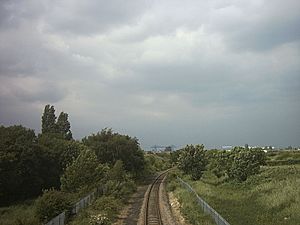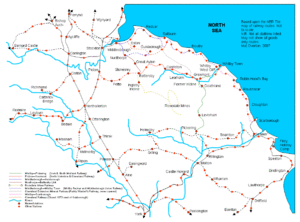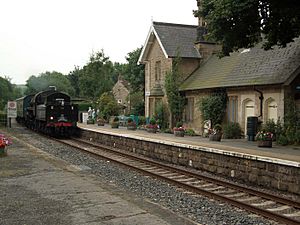Esk Valley line facts for kids
Quick facts for kids Esk Valley Line |
|
|---|---|
| Overview | |
| Status | Operational |
| Owner | National Rail |
| Locale |
|
| Termini | Middlesbrough Whitby |
| Stations | 17 |
| Service | |
| Type | National Rail |
| Operator(s) | Northern Trains |
| Rolling stock | |
| History | |
| Opened | From 1835 |
| Technical | |
| Line length | 30 miles (48 km) |
| Track gauge | 4 ft 8 1⁄2 in (1,435 mm) |
The Esk Valley Line is a railway line in the north of England. It stretches about 30 miles (48 km) from Middlesbrough to Whitby. For much of its eastern part, the line follows the River Esk.
In July 2005, the Esk Valley Line became a special "community rail" line. This means it helps connect local communities. It was one of the first lines chosen for this plan by the government.
Contents
Train Services on the Esk Valley Line
As of December 2019, Northern Trains runs trains on this line. Trains run every hour between Middlesbrough and Nunthorpe. Six trains a day (four on Sundays) continue all the way to Whitby.
On weekdays and Saturdays, extra trains run. Some go from Middlesbrough to Castleton Moor. Others go to Battersby.
The trains usually used on the Esk Valley Line are Class 156 and Class 158 trains. These are special diesel trains. They were first used in the late 1980s.
These trains are currently being updated. They will soon have free WiFi and power sockets. They will also have new passenger information screens and a fresh look inside.
Older trains called Class 142 'Pacer' trains used to run here. They were taken out of service recently. Class 144 'Pacer' trains were also used until about 2005.
The Esk Valley Line is one of England's most countryside railway lines. Its main job is to link Whitby and the North York Moors with Middlesbrough.
You can connect to old-fashioned steam trains at Grosmont and Whitby. These trains run on the North Yorkshire Moors Railway.
The Esk Valley Line stops at these stations:
- Middlesbrough
- James Cook University Hospital
- Marton
- Gypsy Lane
- Nunthorpe
- Great Ayton
- Battersby
- Kildale
- Commondale
- Castleton Moor
- Danby
- Lealholm
- Glaisdale
- Egton
- Grosmont
- Sleights
- Ruswarp
- Whitby
History of the Esk Valley Line
The Esk Valley Line was once part of a much bigger railway system. Most of it was closed during the time of the Beeching cuts. This was when many railway lines were shut down in the 1960s. Today's line is made up of four older railway sections.
Whitby Town to Grosmont
The first part of the line opened in 1835. It ran between Whitby Town and Grosmont. The next year, it was made longer to reach Pickering.
At first, horses pulled the trains on this line. In 1845, it was changed so steam trains could use it. This happened after the York & North Midland Railway took over. By 1854, it became part of the North Eastern Railway.
The section between Grosmont and Pickering closed in 1965. This was due to the Beeching cuts. But it was one of the first lines to be saved by private groups. It is now a special old-fashioned railway called the North Yorkshire Moors Railway.
From Whitby Town, a single track went up a steep hill. Trains could then reach Whitby West Cliff.
From West Cliff, trains could go north along the coast. This was the Whitby, Redcar and Middlesbrough Union Railway. It went towards Staithes and Loftus. Trains could also go south over the Larpool Viaduct to Scarborough.
The Whitby, Redcar and Middlesbrough Union Railway closed in the 1950s. However, the northern part of the line is still used. Trains still run between Middlesbrough and Saltburn.
Between Saltburn and Boulby, the line is also still open. But it is only used for goods trains. These trains carry potash and rock salt from Boulby Mine.
After the Whitby, Redcar & Middlesbrough Union Railway closed, more trains started using the Esk Valley Line. In summer 1957, only 6 trains ran each day. By summer 1958, there were 15 trains daily. Six of these continued to Scarborough.
Grosmont to Battersby
The second line ran east from Picton. There it met the Northallerton to Eaglescliffe Line. The North Yorkshire & Cleveland Railway built this line. It later joined the North Eastern Railway in 1858.
This line was built in stages. It opened for mineral trains to Battersby on April 6, 1858. Passenger trains started running from Stokesley to Castleton Moor on April 1, 1861. The last part of this line opened on October 2, 1865. This was the section between Grosmont and Castleton Moor.
The section between Battersby and Picton closed to passengers in 1954.
From Battersby, goods trains also went south to Ingleby. There, a cable system pulled wagons up a steep slope. They went across the North York Moors to iron ore mines at Rosedale and Farndale.
Between Glaisdale and Lealholm, work began on another line. Engineer John Waddell started building a branch line across the North York Moors. This was to get more iron ore from the area. The plan was to connect it to a line from Guisborough. But the price of iron ore fell, so the line was never finished.
You can still see parts of this unfinished line today. There are large earthworks, like unfinished hills and ditches. The line was supposed to have one station at Stonegate. Nearby, a tunnel was dug using the "cut and cover" method. The only bridge built on this line is at Rake Farm. It is between Lealholm and Glaisdale. This is where it was meant to join the Esk Valley Line.
This unfinished line is still known as "Paddy Waddell's Railway." This is because many Irish workers, called navvies, helped build it.
Today, Battersby only serves one railway line. But it still looks like a "Y" shape. Trains pull into a station that is now like the end of the line. The old line towards Picton continues past the station and then stops. The train driver has to move to the other end of the train to drive towards Middlesbrough or Whitby.
Battersby to Nunthorpe
The part of the Esk Valley Line between Battersby and Nunthorpe is the newest section. It was built in 1864. The goal was to connect the Picton to Grosmont line with the Middlesbrough to Guisborough line.
The line leaves Battersby heading east, like the route to Grosmont. Then it makes a sharp turn north. It then reaches the old line towards Guisborough at Nunthorpe Junction.
Nunthorpe to Middlesbrough

The Middlesbrough & Guisborough Railway built this section in 1854. It was made to serve the town of Guisborough and the area around the Eston Hills.
A line was built going south from Middlesbrough. It went through Nunthorpe. From there, it curved east to Guisborough. Then it continued towards the coast to join the Whitby, Redcar & Middlesbrough Union Railway. It also served several stone quarries in the area.
Even though it was close to the Picton to Battersby line, it took 10 more years to build a link between them. The line from Nunthorpe Junction to Guisborough closed in 1964. Only the section from Middlesbrough to Battersby remained open.
A new station, James Cook, opened on this line in May 2014. It was built to serve the nearby James Cook University Hospital in Middlesbrough.
How Trains are Controlled
The Esk Valley Line still uses a special system called a physical token system. This means train drivers use a physical "token" to show they have permission to be on a certain part of the track. This system is called No Signalman Token Remote. It is also used on other lines like the Heart of Wales Line and the Tarka Line.
At Whitby, Glaisdale, and Battersby, there are special boxes. A signalman at Nunthorpe also helps. They give "key tokens" to train drivers. This token allows only one train to be on a section of track at a time. This keeps everyone safe.
Until the mid-1980s, the line from Whitby to Sleights had two tracks. These were removed, along with a passing loop at Castleton Moor. Trains can still pass each other at Glaisdale and Battersby. However, Glaisdale is now the only station on the single track part that regularly uses both platforms for trains going in different directions.
Between Nunthorpe and Guisborough Junction, the railway has been a single track since 1986. But the station at Nunthorpe still has a passing loop. This means it has separate platforms for trains going "up" and "down" the line. This section is controlled from Middlesbrough.
Steam Train Rides
The North Yorkshire Moors Railway runs old-fashioned steam trains. These trains travel between Whitby and Grosmont.
To make it easier for these steam trains to run directly from the North Yorkshire Moors Line, a new token system was added at Grosmont in 2007. This means a token for the Glaisdale to Whitby section can be picked up or returned at Grosmont.
Before this, for steam trains to go to Whitby, a signalman had to drive to Glaisdale. They would then pick up or return the token key.
How Many People Use the Line
Since 2005, when the Community Rail Partnership started, more and more people have used the Esk Valley Line. Passenger numbers have gone up by as much as 50% by May 2018. Northern and the Community Rail Partnership expect even more people to use the line. This is because new services were added in December 2019.
| Station usage | |||||||||||||||||
|---|---|---|---|---|---|---|---|---|---|---|---|---|---|---|---|---|---|
| Station name | 2002–03 | 2004–05 | 2005–06 | 2006–07 | 2007–08 | 2008–09 | 2009–10 | 2010–11 | 2011–12 | 2012–13 | 2013–14 | 2014–15 | 2015–16 | 2016–17 | 2017–18 | 2018–19 | 2019–20 |
| Middlesbrough | 902,723 | 1,120,781 | 1,200,737 | 1,242,054 | 1,300,713 | 1,349,420 | 1,354,030 | 1,426,350 | 1,423,134 | 1,364,250 | 1,370,172 | 1,351,494 | 1,331,452 | 1,356,282 | 1,312,916 | ||
| James Cook | - | - | - | - | - | - | - | - | - | - | - | 23,176 | 31,578 | 31,402 | 33,774 | ||
| Marton | 2,527 | 3,617 | 3,076 | 3,833 | 4,825 | 6,894 | 8,750 | 9,804 | 9,130 | 9,862 | 10,576 | 10,568 | 13,512 | 13,696 | 13,356 | ||
| Gypsy Lane | 7,263 | 10,353 | 11,412 | 12,020 | 12,820 | 18,430 | 20,234 | 23,566 | 22,692 | 21,900 | 23,716 | 26,398 | 30,338 | 32,996 | 33,298 | ||
| Nunthorpe | 8,152 | 11,403 | 12,406 | 13,747 | 16,775 | 23,208 | 23,828 | 24,914 | 22,302 | 22,600 | 24,203 | 32,510 | 35,766 | 35,814 | 34,596 | ||
| Great Ayton | 3,369 | 4,297 | 4,405 | 4,738 | 5,666 | 5,650 | 6,134 | 6,798 | 6,904 | 5,738 | 6,826 | 7,776 | 7,100 | 6,890 | 7,322 | ||
| Battersby | 1,314 | 1,591 | 1,653 | 1,711 | 2,028 | 1,806 | 2,012 | 1,476 | 1,504 | 1,574 | 1,592 | 1,488 | 1,458 | 1,660 | 1,564 | ||
| Kildale | 1,373 | 1,956 | 1,664 | 2,160 | 2,486 | 2,308 | 2,006 | 1,992 | 2,018 | 1,822 | 1,960 | 1,824 | 1,610 | 1,416 | 1,630 | ||
| Commondale | 4,756 | 3,219 | 2,976 | 2,959 | 2,974 | 3,142 | 2,858 | 3,972 | 5,000 | 4,852 | 5,026 | 4,602 | 5,232 | 3,754 | 1,888 | ||
| Castleton Moor | 30,270 | 6,452 | 7,174 | 6,062 | 5,613 | 5,172 | 5,544 | 5,164 | 5,030 | 4,850 | 4,892 | 4,858 | 4,930 | 5,444 | 6,182 | ||
| Danby | 24,545 | 23,729 | 21,899 | 18,760 | 12,560 | 9,710 | 11,370 | 10,878 | 11,622 | 9,902 | 10,836 | 8,440 | 7,084 | 6,334 | 6,810 | ||
| Lealholm | 18,657 | 16,760 | 16,688 | 15,706 | 13,044 | 15,554 | 16,242 | 17,972 | 20,010 | 11,422 | 17,662 | 15,888 | 18,102 | 17,358 | 16,298 | ||
| Glaisdale | 23,129 | 28,071 | 26,887 | 26,355 | 22,276 | 20,284 | 18,686 | 21,222 | 18,564 | 11,194 | 15,216 | 15,046 | 18,754 | 18,298 | 20,140 | ||
| Egton | 12,149 | 11,818 | 13,546 | 11,292 | 10,798 | 12,414 | 11,110 | 9,430 | 10,562 | 7,388 | 11,568 | 10,812 | 13,724 | 12,088 | 12,878 | ||
| Grosmont | 17,968 | 19,601 | 18,675 | 18,264 | 24,273 | 19,718 | 22,048 | 22,964 | 23,662 | 16,376 | 17,912 | 16,144 | 15,172 | 13,514 | 13,912 | ||
| Sleights | 2,482 | 3,116 | 3,733 | 3,480 | 3,976 | 3,884 | 4,334 | 4,292 | 4,592 | 4,378 | 4,426 | 5,040 | 4,122 | 4,188 | 4,245 | ||
| Ruswarp | 2,003 | 2,716 | 2,585 | 2,301 | 2,696 | 3,054 | 2,606 | 2,722 | 2,974 | 2,946 | 3,032 | 3,228 | 2,966 | 2,568 | 2,686 | ||
| Whitby | 149,365 | 132,049 | 132,956 | 127,428 | 127,739 | 120,594 | 126,240 | 133,940 | 140,158 | 107,940 | 133,680 | 130,210 | 137,196 | 131,810 | 138,492 | ||
| The annual passenger usage is based on sales of tickets in stated financial years from Office of Rail and Road estimates of station usage. The statistics are for passengers arriving and departing from each station and cover twelve month periods that start in April. Methodology may vary year on year. Barking and Blackhorse Road are affected by usage of the ticket gates for the underground and that Gospel Oak connects to the North London Line section of the London Overground and is similarly affected. Barking is further affected by the ticket gates used to access C2C services. | |||||||||||||||||
Note: James Cook station opened on May 18, 2014.
Future Plans for the Line
Local councils have suggested a new "park and ride" station. It would be located between Nunthorpe and Great Ayton. This station, called Roseberry Parkway, would help over 70,000 people. It aims to encourage car drivers to use the train instead. This would help reduce traffic jams on roads leading into Middlesbrough.
The project also plans to increase train services to Middlesbrough. They want trains to run every half hour. They also plan to double the number of trains on the Esk Valley Line to Whitby.
After the December 2019 timetable change, Northern added two new return trips. These run on weekdays and Saturdays. One trip is in the morning, helping people travel from Whitby to Middlesbrough for work. The other trip provides a later train service in the evening.




